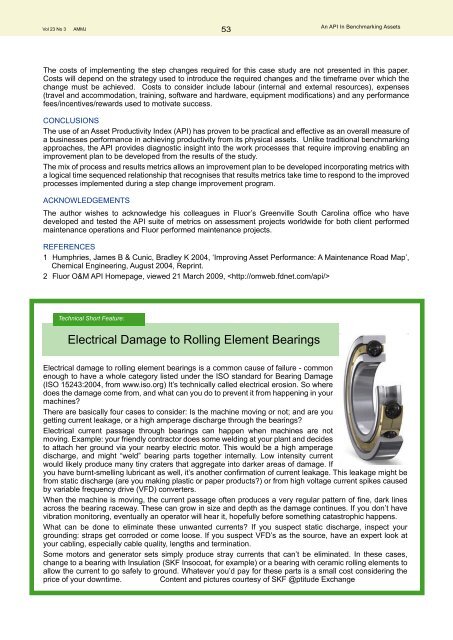SKF Reliability Systems - Library
SKF Reliability Systems - Library
SKF Reliability Systems - Library
Create successful ePaper yourself
Turn your PDF publications into a flip-book with our unique Google optimized e-Paper software.
Vol 23 No 3 AMMJ<br />
The costs of implementing the step changes required for this case study are not presented in this paper.<br />
Costs will depend on the strategy used to introduce the required changes and the timeframe over which the<br />
change must be achieved. Costs to consider include labour (internal and external resources), expenses<br />
(travel and accommodation, training, software and hardware, equipment modifications) and any performance<br />
fees/incentives/rewards used to motivate success.<br />
CONCLUSIONS<br />
The use of an Asset Productivity Index (API) has proven to be practical and effective as an overall measure of<br />
a businesses performance in achieving productivity from its physical assets. Unlike traditional benchmarking<br />
approaches, the API provides diagnostic insight into the work processes that require improving enabling an<br />
improvement plan to be developed from the results of the study.<br />
The mix of process and results metrics allows an improvement plan to be developed incorporating metrics with<br />
a logical time sequenced relationship that recognises that results metrics take time to respond to the improved<br />
processes implemented during a step change improvement program.<br />
ACKNOWLEDGEMENTS<br />
53<br />
An API In Benchmarking Assets<br />
The author wishes to acknowledge his colleagues in Fluor’s Greenville South Carolina office who have<br />
developed and tested the API suite of metrics on assessment projects worldwide for both client performed<br />
maintenance operations and Fluor performed maintenance projects.<br />
REFERENCES<br />
1 Humphries, James B & Cunic, Bradley K 2004, ‘Improving Asset Performance: A Maintenance Road Map’,<br />
Chemical Engineering, August 2004, Reprint.<br />
2 Fluor O&M API Homepage, viewed 21 March 2009, <br />
Technical Short Feature:<br />
Electrical Damage to Rolling Element Bearings<br />
Electrical damage to rolling element bearings is a common cause of failure - common<br />
enough to have a whole category listed under the ISO standard for Bearing Damage<br />
(ISO 15243:2004, from www.iso.org) It’s technically called electrical erosion. So where<br />
does the damage come from, and what can you do to prevent it from happening in your<br />
machines?<br />
There are basically four cases to consider: Is the machine moving or not; and are you<br />
getting current leakage, or a high amperage discharge through the bearings?<br />
Electrical current passage through bearings can happen when machines are not<br />
moving. Example: your friendly contractor does some welding at your plant and decides<br />
to attach her ground via your nearby electric motor. This would be a high amperage<br />
discharge, and might “weld” bearing parts together internally. Low intensity current<br />
would likely produce many tiny craters that aggregate into darker areas of damage. If<br />
you have burnt-smelling lubricant as well, it’s another confirmation of current leakage. This leakage might be<br />
from static discharge (are you making plastic or paper products?) or from high voltage current spikes caused<br />
by variable frequency drive (VFD) converters.<br />
When the machine is moving, the current passage often produces a very regular pattern of fine, dark lines<br />
across the bearing raceway. These can grow in size and depth as the damage continues. If you don’t have<br />
vibration monitoring, eventually an operator will hear it, hopefully before something catastrophic happens.<br />
What can be done to eliminate these unwanted currents? If you suspect static discharge, inspect your<br />
grounding: straps get corroded or come loose. If you suspect VFD’s as the source, have an expert look at<br />
your cabling, especially cable quality, lengths and termination.<br />
Some motors and generator sets simply produce stray currents that can’t be eliminated. In these cases,<br />
change to a bearing with Insulation (<strong>SKF</strong> Insocoat, for example) or a bearing with ceramic rolling elements to<br />
allow the current to go safely to ground. Whatever you’d pay for these parts is a small cost considering the<br />
price of your downtime. Content and pictures courtesy of <strong>SKF</strong> @ptitude Exchange

















